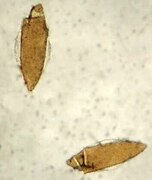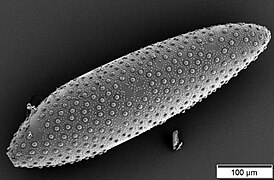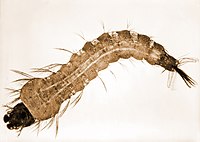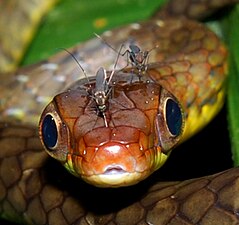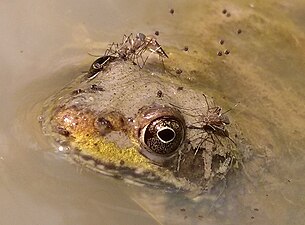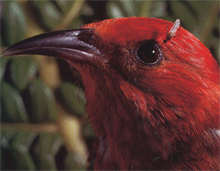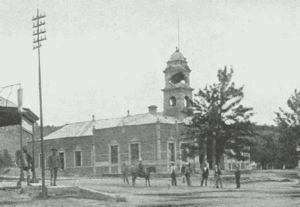모기
Mosquito| 모기 Temporal range: Early Cretaceous (Barremian) – Recent | |
|---|---|
 | |
| Aedes aegypti | |
| 과학 분류 | |
| 도메인: | 진핵생물 |
| 왕국: | 애니멀리아 |
| 문: | 절지동물 |
| 클래스: | 인테오페라속 |
| 주문: | 디프테라 |
| 슈퍼패밀리: | 쿠리코이데아 |
| 가족: | 꽃매미과 메이겐, 1818년[1] |
| 하위 패밀리 | |
| 다양성 | |
| 112속 | |
모기는 3,600종으로 구성된 작은 파리과입니다. "모스카"(mosca와 diminal -ito)[2]는 스페인어로 "작은 파리"를 의미합니다.[3][4] 모기는 가늘고 분절된 몸, 한 쌍의 날개, 세 쌍의 긴 털 같은 다리, 그리고 전문적이고 매우 길쭉한 피어싱을 하는 입 부분을 가지고 있습니다. 모든 모기들은 꽃에서 꿀을 마십니다; 게다가 일부 종의 암컷들은 피를 마시는데 적응했습니다. 진화 생물학자들은 모기를 미세 포식자, 즉 모기를 바로 죽이지 않고 피를 마심으로써 더 큰 모기에 기생하는 작은 동물로 보고 있습니다. 의학 기생충학자들은 대신 모기를 한 숙주에서 다른 숙주로 원생동물 기생충 또는 박테리아 또는 바이러스 병원체를 옮기는 질병의 매개체로 보고 있습니다.
모기의 수명 주기는 알, 유충, 번데기, 성충의 4단계로 구성되어 있습니다. 알은 수면에 알을 낳는데, 수중 조류와 유기물을 먹고 사는 운동성 유충으로 부화합니다. 이 유충들은 잠자리 애벌레, 많은 물고기, 그리고 몇몇 새들과 같은 많은 민물 동물들에게 중요한 식량원입니다. 많은 종의 성체 암컷은 숙주의 피부를 뚫고 다양한 척추동물 숙주와 일부 무척추동물, 주로 다른 절지동물의 피를 먹고 살도록 적응된 입을 가지고 있습니다. 일부 종은 혈액 식사 후에만 알을 생산합니다.
모기의 침은 물린 동안 숙주로 옮겨지고 가려운 발진을 일으킬 수 있습니다. 게다가, 피를 먹이는 종은 무는 동안 병원체를 섭취하고, 다른 숙주에게 전염시킬 수 있습니다. 이 종은 말라리아, 필라리아증과 같은 기생충 질병과 황열병, 뎅기열과 같은 아르보바이러스 질병의 매개체를 포함합니다. 질병을 전염시킴으로써, 모기들은 매년 725,000명 이상의 사람들의 사망을 야기합니다.
설명 및 생애주기

모든 파리와 마찬가지로 모기도 생애주기에서 알, 유충, 번데기, 성충의 네 단계를 거칩니다. 처음 세 단계인 알, 유충, 번데기는 대부분 수중에 있으며 [5]알은 보통 고인 물에 낳습니다.[6] 부화하여 유충이 되고, 번데기로 변할 때까지 먹이를 먹고 자라고 털갈이를 합니다. 다 자란 번데기가 수면에 떠오르면서 성충 모기가 나옵니다. 모기의 성체 수명은 짧게는 일주일에서 길게는 한 달 정도입니다. 일부 종은 휴면 상태에서 성체로 월동합니다.[7]
어른
모기는 표면에 뚜렷한 비늘이 있는 한 쌍의 날개를 가지고 있습니다. 그들의 날개는 길고 좁은 반면에 다리는 길고 얇습니다. 몸은 보통 회색이나 검은색으로 가늘고, 보통 3~6mm 길이입니다. 모기들은 휴식을 취할 때 첫 번째 다리를 밖으로 내밀고 있는 반면, 다소 비슷한 치로노미드 지렁이들은 이 다리를 앞으로 내밀고 있습니다.[8] 아노펠레스 모기는 1~2km/h (0.62~1.24mph)의 속도로 최대 4시간 동안 연속적으로 날 수 있으며,[9] 하룻밤에 최대 12km(7.5마일)까지 이동할 수 있습니다. 수컷은 가슴을 진동시키는 근육에 의해 간접적으로 움직이는 초당 450에서 600회 사이에 날개를 뜁니다.[10][11] 모기는 주로 작은 파리이며, 가장 큰 것은 톡소린카이트속으로 길이는 최대 18mm(0.71인치), 날개폭은 24mm(0.94인치)입니다.[12] 흰줄숲모기속(Aedes)은 날개폭이 2.8~4.4mm(0.11~0.17인치)로 훨씬 더 작습니다.[13]
모기는 불과 5일 만에 더운 날씨에 알에서 성충으로 발전할 수 있지만 최대 한 달까지 걸릴 수도 있습니다.[14] 새벽이나 황혼에 번데기가 된 지 며칠 안에 수컷들은 떼를 지어 모여 암컷들이 날아들 때 짝짓기를 합니다.[15] 암컷은 평생 단 한 번, 수컷이 내뿜는 페로몬에 이끌려 짝짓기를 합니다.[16][17] 알이 자라기 위해 피를 필요로 하는 종에서 암컷은 숙주를 찾아 피를 가득 마십니다. 그런 다음 먹이를 소화하고 알이 자라도록 하기 위해 2, 3일 동안 휴식을 취합니다. 그런 다음 알을 낳고 먹이 주기와 산란 주기를 반복할 준비가 되어 있습니다.[15] 암컷은 온도, 습도, 혈액 식사를 얻는 능력, 척추동물 숙주에 의해 죽임을 당하는 것을 피함에 따라 야생에서 최대 3주 동안 살 수 있습니다.[15][18]
- 성체 암컷 모기의 해부학적 구조
달걀
대부분의 모기의 알은 연못, 습지, 일시적인 웅덩이, 나무에 물이 채워진 구멍, 또는 브로멜리앗의 물받이 잎겨드랑이일 수 있는 고인 물에 낳습니다. 어떤 것들은 물 가장자리 근처에 눕고 다른 것들은 수생 식물에 알을 붙입니다. Opifex fuscus와 같은 소수는 염습지에서 번식할 수 있습니다.[6] 와이오미야 스미시(Wyeomyia smithii)는 투수성 식물의 투수에서 번식하며, 유충은 그곳에서 익사한 부패한 곤충을 먹고 삽니다.[19]
산란, 알 낳는 것은 종에 따라 다릅니다. 아노펠레스 암컷은 물 위를 날아다니며, 한 번에 하나씩 표면 위에 알을 올려놓기 위해 아래로 만지거나 두드려집니다; 그들의 알은 대략 시가 모양이고 그들의 옆으로 떠내려갑니다. 암컷은 일생 동안 100-200개의 알을 낳을 수 있습니다.[15] 물 근처의 축축한 진흙이나 다른 표면에 알을 떨어뜨린 지 얼마 되지 않아 물에 잠기면 알이 부화합니다.[20] 쿨렉스(Culex), 쿨리세타(Culiseta), 우라노타니아(Uranotaenia)와 같은 속의 암컷은 떠다니는 뗏목에 알을 낳습니다.[21][22] 대조적으로 만소니아 암컷은 알을 배열하여 낳는데, 보통 물총 패드의 표면 아래에 붙어 있습니다.[23]
대부분의 모기 종의 알은 동시에 부화하지만, 휴면 상태의 Aedes 알은 장기간에 걸쳐 불규칙하게 부화합니다.[20]
라바
모기 유충의 머리에는 먹이를 주는 데 사용되는 두드러진 입솔, 다리가 없는 큰 가슴, 분절된 복부가 있습니다. 복부에 있는 사이펀을 통해 공기를 들이마시기 때문에 자주 수면으로 나와야 합니다. 물 표면층에 있는 조류, 박테리아 및 기타 미생물을 먹이로 삼는 데 대부분의 시간을 보냅니다. 방해를 받으면 표면 아래로 잠수합니다. 그것은 입 브러시로 자신을 밀어 넣거나, 위험하게 몸을 꿈틀꿈틀 꿈틀꿈틀 움직이며 수영합니다. 그것은 여러 단계, 즉 매 번 털갈이를 통해 발달하고, 그 후 번데기로 변합니다.[14] 아주 어릴 때를 제외하고는 건조를 견딜 수 있고, 연못이 마르면 몇 달 동안 휴면 상태에 빠집니다.[20]
푸파
번데기의 머리와 가슴은 두흉으로 합쳐지고 복부는 그 아래로 휘어져 있습니다. 번데기나 "텀블러"는 배를 뒤집어서 활발하게 수영할 수 있습니다. 애벌레와 마찬가지로 대부분의 종의 번데기는 숨을 쉬기 위해 자주 수면으로 나와야 하며, 이는 두흉부에 있는 한 쌍의 호흡 나팔을 통해 이루어집니다. 그들은 먹이를 먹지 않습니다. 그들은 호흡 나팔에 의해 수면에 매달려 있는 시간의 대부분을 보냅니다. 놀란다면, 그들은 유충과 거의 같은 방식으로 배를 뒤집어서 아래로 헤엄쳐 내려갑니다. 방해받지 않으면, 그들은 곧 다시 떠오릅니다. 성충은 물 표면의 번데기에서 나와 날아갑니다.[14]
- 성충이 나오기 직전의 모기 번데기. 머리와 가슴은 두흉부에 융합되어 있습니다.
어른들의 먹이주기
다이어트

수컷과 암컷 모기 모두 꿀, 진딧물 꿀, 식물 즙을 [18]먹지만 많은 종에서 암컷은 피를 빨아먹는 외부기생충이기도 합니다. 그러한 종들 중 일부에서는 혈액 식사가 난자 생산에 필수적입니다. 다른 종들에서는 암컷이 더 많은 난자를 낳을 수 있도록 해줍니다.[24] 식물 재료와 혈액은 모두 설탕 형태의 유용한 에너지원입니다. 혈액은 지질과 같은 농축 영양소를 더 많이 공급하지만, 혈액 식사의 주요 기능은 달걀 생산을 위한 단백질을 얻는 것입니다.[25][26] 톡소린카이트와 같은 모기는 혈액 식사가 필요하지 않고 자가 번식합니다. 아노펠레스나 아에데스 같은 질병 매개 모기들은 자생적이어서 알을 낳기 위해서는 피가 필요합니다. 많은 쿨렉스 종들은 부분적으로 자생적이며, 두 번째와 그 이후의 알을 움켜쥐기 위해서만 피가 필요합니다.[27]
숙주동물
피를 빨아먹는 모기는 특정 숙주 종을 선호하지만 먹이가 부족할 때는 덜 선택적입니다. 다른 모기 종들은 양서류, 뱀, 새, 포유류를 선호합니다. 예를 들어, 쿨리세타 멜라누라는 지나가는 새의 피를 빨아먹지만, 모기 수가 증가함에 따라 말과 사람을 포함한 포유류를 공격하여 북미에서 말 뇌염 바이러스가 유행하고 있습니다.[28] 많은 물림으로 인한 혈액 손실은 많은 양으로 증가할 수 있으며 때때로 소와 말만큼 큰 가축의 죽음을 야기할 수 있습니다.[29] 말라리아를 전염시키는 모기들은 애벌레를 찾아 헤모림프를 먹고 [30]살기 때문에 모기들의 발달을 방해합니다.[31]
- 뱀에게 먹이를 주는 것
- 개구리 먹이 먹기
- 새를 잡아먹습니다.
호스트 찾기

대부분의 모기 종은 구근성으로 새벽이나 황혼에 먹이를 먹고 낮의 더위를 뚫고 서늘한 곳에서 휴식을 취합니다.[32] 아시아 호랑이 모기와 같은 일부 종은 낮에 날아서 먹이를 먹는 것으로 알려져 있습니다.[33] 암컷 모기는 숙주에서 발생하는 이산화탄소(CO2)와 1-옥텐-3-올(버섯 알코올, 호기에서 발견됨) 등의 냄새를 맡고, 시각 인식을 통해 숙주를 사냥합니다.[34] 쿨렉스 퀸퀘파시아투스를 가장 강하게 끌어당기는 반화학물질은 노나날입니다.[35] 또 다른 매력은 설카톤입니다.[36] 모기의 후각, 즉 후각 시스템의 상당 부분은 혈액원을 냄새 맡는 데 사용됩니다. 더듬이에 있는 72가지 유형의 냄새 수용체 중 적어도 27가지는 땀에서 발견되는 화학 물질을 감지하도록 조정됩니다.[37] Aedes에서 호스트를 찾는 작업은 두 단계로 이루어집니다. 먼저, 모기는 숙주의 냄새를 감지할 때까지 날아다니다가, 냄새의 농도를 가이드로 삼아 모기를 향해 날아갑니다.[38] 모기는 O형 혈액, 피부 박테리아가 풍부한 사람, 체온이 높은 사람, 임산부를 먹이로 삼는 것을 선호합니다.[39][40] 모기에 대한 개인의 매력은 유전적이고 유전적으로 통제되는 구성 요소를 가지고 있습니다.[41]
입 부분
암컷 모기 입 부분은 피부를 찌르고 피를 빨아먹는 데 매우 적합합니다. 수컷은 설탕이 든 액체만 마시고, 전문화된 입 부분은 적습니다.[42]
외부적으로 모기의 가장 명백한 먹이 구조는 6개의 날카로운 입 부분이나 스타일트로 이루어진 다발(근막)을 덮는 우천처럼 U자 모양의 라비움으로 구성된 프로코시스입니다. 하악 2개, 상악 2개, 인두 저음, 실험실입니다. 모기가 물어뜯기 시작하면 라비움은 다시 활 모양으로 구부러져 피부와 접촉하며 스타일을 아래로 유도합니다. 턱과 상악의 아주 날카로운 끝이 앞뒤로 움직여 피부 속으로 들어가는 것을 볼 수 있는데, 바늘로 피부를 관통하는 데 필요한 힘의 1,000분의 1만으로 고통 없이 삽입됩니다.[43][44][45]
- 암컷 모기가 피를 빨아먹는 동안 입 부분은 숙주의 피부를 관통하는 피어싱과 흡인관을 지지하는 유연한 라비움 칼집을 보여줍니다.
타액
모기의 침에는 당을 먹이는 데 도움이 되는 효소와 [46]당분의 세균 증식을 조절하는 항균제가 들어 있습니다.[47]
모기가 혈액을 얻기 위해서는 척추동물 숙주의 생리적 반응을 우회해야 합니다. 모기 침은 혈관 수축, 혈액 응고, 혈소판 응집을 감소시키는 단백질로 숙주의 지혈 시스템을 차단하여 혈액이 계속 흐르게 합니다.[48] It modulates the host's immune response via a mixture of proteins which lower angiogenesis and immunity; create inflammation;[48][49] suppress tumor necrosis factor release from activated mast cells;[50] suppress interleukin (IL)-2 and IFN-γ production;[51][52] suppress T cell populations;[53][54][55] decrease expression of interferon−α/β, 바이러스 감염을 더 심각하게 만들고 [56][57]혈액 내 자연 살해 T 세포를 증가시키고 사이토카인 생성을 감소시킵니다.[58]
난자의 발육과 혈액의 소화
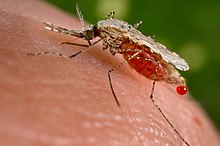
많은 피를 먹이는 종의 암컷들은 알의 발달 과정을 시작하기 위해 피를 먹는 식사가 필요합니다. 충분히 많은 양의 혈액을 섭취하면 호르몬 캐스케이드가 발생하여 난자가 발생합니다.[59] 먹이를 다 먹이면 모기는 주둥이를 빼내고, 내장이 차오르면서 위내막은 혈액을 둘러싸고 있는 복막을 분비합니다. 이것은 혈액을 위 속의 다른 것들과 분리되게 합니다. 묽은 액체 식단으로 생존하는 많은 헤미프테라와 마찬가지로 많은 성충 모기는 먹이를 줄 때도 잉여 액체를 배설합니다. 이를 통해 암컷은 영양 고형물을 가득 채울 수 있습니다. 혈액 식사는 며칠 동안 소화됩니다.[60] 혈액이 위에 있으면 중장은 주로 아미노펩티다아제의 도움을 받는 트립신인 단백질분해효소 효소를 합성하여 혈액 단백질을 유리 아미노산으로 가수분해합니다. 이것들은 비텔로게닌의 합성에 사용되며, 이는 다시 난황 단백질로 만들어집니다.[61]
생태 및 분포
분배
모기는 남극을 제외한 모든 육지 지역과 근본적으로 모기가 없는 아이슬란드와 같이 극지방 또는 아극지방 기후를 가진 몇몇 섬에서 발생하는 전세계적인 분포를 가지고 있습니다.[62] 이러한 부재는 아마도 아이슬란드의 기후 때문일 것입니다. 날씨는 예측할 수 없고, 얼지만 종종 한겨울에 갑자기 따뜻해져서 모기들이 휴면 상태에서 번데기에서 나오고, 수명 주기를 마치기도 전에 다시 얼어버립니다.[63][64]
온대 모기의 알은 따뜻한 지역에 자생하는 종의 알보다 추위에 더 강합니다.[65][66] 많은 사람들이 영하의 온도를 견딜 수 있는 반면, 일부 종의 성충은 건물이나 속이 빈 나무와 같은 미세 서식지에 은신함으로써 겨울을 살아남을 수 있습니다.[67] 따뜻하고 습한 열대 지역에서는 일부 모기 종이 1년 내내 활동하지만, 온대와 추운 지역에서는 겨울잠을 자거나 휴면기에 들어갑니다. Simuliidae 및 Ceratopogonidae와 같은 과의 다른 북극 지렁이와 같은 북극 또는 아북극 모기는 영구 동토층에 용탕 웅덩이가 형성됨에 따라 연간 몇 주 동안만 활동할 수 있습니다. 하지만, 그 기간 동안, 그들은 일부 지역에서 엄청난 숫자로 나타나며 순록 무리에서 각각의 동물로부터 하루에 300ml의 피를 섭취할 수도 있습니다.[68]
모기가 질병을 옮기기 위해서는 주로 습도, 기온, 강수량과 [69]같은 계절적으로 유리한 조건이 있어야 합니다.[70] 엘니뇨는 동아프리카, 라틴 아메리카, 동남아시아 및 인도에서 발생 위치와 수에 영향을 미칩니다. 기후 변화는 계절적 요인에 영향을 미치고 모기를 분산시킵니다.[71] 기후 모델은 과거 발병을 재현하고 한 지역의 예측된 기후를 기반으로 벡터 매개 질병의 위험을 예측하는 데 과거 데이터를 사용할 수 있습니다.[72] 모기 매개 질병은 오랫동안 동아프리카, 라틴 아메리카, 동남아시아 및 인도에서 가장 널리 퍼졌습니다. 유럽에서의 출현은 21세기 초에 관찰되었습니다. 2030년에는 영국 남부의 기후가 1년 중 두 달 동안 열대열원충 말라리아 전염에 적합하고, 2080년에는 스코틀랜드 남부도 마찬가지일 것으로 예측됩니다.[73][74]
포식자와 기생충
모기 유충은 연못에서 가장 흔한 동물 중 하나이며 담수 포식자에게 중요한 먹이 공급원을 형성합니다. 모기 유충을 잡는 많은 수서곤충 중에는 잠자리와 담쟁이덩굴, 쇠똥구리, 물벼룩 등이 있습니다. 척추동물 포식자로는 메기나 모기 같은 물고기, 가래톳이나 대왕개구리 같은 양서류, 붉은귀슬라이더 같은 민물거북, 오리 같은 새들이 있습니다.[75]
성충은 맹금류와 돌무지개과를 포함한 포식성 파리와 거미에 의해 연못 표면에서 소비됩니다. 날아다니는 성충은 잠자리나 담쟁이, 스위프트나 제비 같은 새, 박쥐를 포함한 척추동물에게 포획됩니다.[76]
모기는 수각류 진드기, 녹내장과 같은 섬모충류, 텔라니아와 같은 미세포자충류 및 사프롤레그니아과 및 엔토모프토라과 종을 포함한 균류에 의해 기생합니다.[76]
수분작용

Asteraceae, Rosaceae 및 Orchidaceae의 구성원을 포함한 여러 꽃들은 설탕이 풍부한 꿀을 얻기 위해 방문하는 모기에 의해 수분됩니다. 그들은 알코올, 알데히드, 케톤 및 테르펜과 같은 다양한 생화학 물질에 의해 꽃에 끌립니다. 백악기 때부터 모기가 꽃을 찾아 수분을 시켰습니다. 식물을 빨아먹는 모기가 피를 빨아먹는 것에 미리 적응했을 가능성이 있습니다.[18]
기생
생태학적으로 피를 먹이는 모기는 작은 동물로, 큰 동물을 즉시 죽이지 않고 먹이를 먹습니다. 진화 생물학자들은 이것을 기생의 한 형태로 보고 있습니다; Edward O. 윌슨의 구절 "기생충은 먹이를 1 이하 단위로 먹는 포식자입니다."[77] 미세 포식은 기생 내에서 진화적으로 안정된 6가지 주요 전략 중 하나입니다. 기생자나 기생자의 활동과 달리 숙주가 여전히 번식할 수 있도록 하고, 기존의 기생충과 달리 다수의 숙주를 갖는 것이 특징입니다.[78][79] 이러한 관점에서 모기는 외부 기생충으로, 몸 속으로 들어가는 것이 아니라 날카로운 입 부분을 사용하여 숙주의 외부에서 피를 먹고 삽니다. 벼룩이나 이와 같은 다른 외부기생충과 달리 모기는 숙주의 몸에 일정하게 남아 있지 않고 먹이를 주기 위해서만 방문합니다.[79]
진화
화석기록

가장 오래된 것으로 알려진 모기는 레바논 호박에서 발견되는 Libanoculex intermedius로, 약 1억 2천 5백만 년 전 백악기 전기의 바레미안 시대로 거슬러 올라갑니다. 이 종의 수컷 개체의 입 부분은 살아있는 암컷 모기와 비슷하여 살아있는 수컷 모기와 달리 혈액을 섭취했음을 나타냅니다.[81] 백악기 모기의 다른 세 종이 알려져 있습니다. 부르마쿨렉스 안티쿠스와 프리스코쿨렉스 부르마니쿠스는 약 9,900만 년 전 백악기 후기 세노마 시대의 가장 초기 부분으로 거슬러 올라가는 미얀마의 버마 호박에서 유래한 것으로 알려져 있습니다.[82][83] Paleoculicis minutus는 약 7,900만년 전 백악기 후기의 캄파니아 단계로 거슬러 올라가는 캐나다 앨버타 주 출신의 캐나다 호박에서 알려져 있습니다.[84] P. burmanicus는 Anophelinae에 할당되었으며, 이 아과와 Culicinae 사이의 분열이 9,900만 년 전에 일어났다는 것을 나타냅니다.[83] 분자적 추정에 따르면 이 분열은 1억 9,750만 년 전 쥐라기 초기에 일어났지만 백악기에 이르러서야 주요 다양화가 이루어졌다고 합니다.[85]
분류법
112개 속에 3,600종 이상의 모기가 설명되어 있습니다. 그들은 전통적으로 다른 질병을 옮기는 두 개의 아과, Anophelinae와 Culicinae로 나뉩니다. 대략적으로 말하면 말라리아와 같은 원생동물성 질병은 아노펠린에 의해 전염되고 황열병과 뎅기열과 같은 바이러스성 질병은 컬리신에 의해 전염됩니다.[86]
쿨리시과(Culicidae)라는 이름은 독일 곤충학자 요한 빌헬름 마이겐(Johann Wilhelm Meigen)이 1818-1838년에 발표한 7권의 분류에서 소개했습니다.[87] 모기 분류학은 1901년 영국 곤충학자 프레드릭 빈센트 테오발트(Frederick Vincent Theobald)가 컬리시과에 대한 5권짜리 모노그래프를 출판하면서 발전되었습니다.[88] 그는 1898년 식민지 국무장관 조셉 체임벌린의 지시에 따라 전 세계에서 대영박물관(자연사)으로 보내진 모기 표본을 제공받았는데, 그는 "말라리아와 모기의 가능한 연관성을 고려할 때," 다양한 열대 식민지에서 모기와 관련 곤충의 다양한 종에 대한 정확한 지식을 얻는 것이 바람직합니다. 그러므로 나는 당신에게 ...을 묻겠습니다. 사람이나 동물을 물어뜯는 날개 달린 곤충들로 만든 수집품을 식민지에 가져라.'[89]
계통발생학
외부의
모기는 진정한 파리과(Diptera)의 일종입니다. (라틴어 culex, genitive culicis, "midge" 또는 "gnat"[90]을 의미함). 계통수는 플라이트리(FLYTREE) 프로젝트를 기반으로 합니다.[91][92]
| 디프테라 |
| ||||||||||||||||||||||||||||||||||||||||||||||||
| (진정한 파리) |
내부의
Kyanne Reidenbach와 동료들은 2009년에 26종의 핵 DNA와 형태학을 모두 사용하여 모기 계통 발생학을 분석했습니다. 그들은 Anophelinae가 다소 기초적인 것으로 확인되었지만 나무의 더 깊은 부분은 잘 해결되지 않았다고 언급합니다.[93]
| 꽃매미과 |
| ||||||||||||||||||||||||||||||
인간과의 상호작용
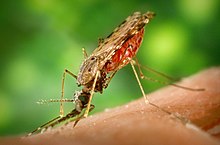
병의 매개체
모기는 박테리아, 바이러스 및 원생동물 기생충을 포함한 많은 질병을 유발하는 미생물의 매개체입니다. 매년 거의 7억 명의 사람들이 모기에 의해 매개되는 질병에 걸리고, 이로 인해 725,000명 이상이 사망합니다.[94] 일반적인 모기 매개 바이러스 질병으로는 주로 이집트숲모기에 의해 전염되는 황열병과[95] 뎅기열이 있습니다.[96] 모기에 의해 전염되는 기생충 질환으로는 말라리아, 림프 여포증 등이 있습니다. 말라리아를 일으키는 열원충 기생충은 암컷 아노펠레스 모기에 의해 옮겨집니다. 코끼리증의 주요 원인인 림프 여포증은 다양한 모기에 의해 전파됩니다.[97] 쿨렉스와 쿨리세타 모기가 전파하는 세균성 질병은 툴레르미아입니다.[98]
통제

번식지 제거, 창문 스크린과 모기장을 통한 배제, 곰팡이와[99][100] 선충과 같은 기생충 [101]또는 물고기,[102][103][104] 요각류,[105] 잠자리 님프와 성충, 도마뱀과 도마뱀붙이의 일부 종과 같은 포식자에 대한 생물학적 방제를 포함하여 모기 방제를 위해 많은 조치가 시도되었습니다.[106] 또 다른 접근 방식은 많은 수의 무균 수컷을 도입하는 것입니다.[107] 값이 싸고 벡터 내성의 영향을 받지 않는 것으로 보이는 해결책인 세포질 비호환성, 염색체 전위, 성 왜곡 및 유전자 대체를 포함한 유전자 변형 방법이 탐구되었습니다.[108] 유전자 드라이브를 이용한 질병 매개 모기의 방제가 제안되었습니다.[109][110]
구충제

방충제는 피부에 바르고 모기에 물리는 것을 단기적으로 보호합니다. 화학적 DEET는 일부 모기와 다른 곤충들을 물리칩니다.[111] CDC가 권장하는 일부 기피제는 피카리딘, 유칼립투스 오일(PMD), 에틸부틸아미노프로피오네이트(IR3535)입니다.[112] Pyrethrum(국화 종, 특히 C. cinerariifolium 및 C. coccineum)은 효과적인 식물 기반 구충제입니다.[113] 곤충(및 모기)을 멀리하기 위한 초음파를 생성하는 전자 방충 장치가 판매되고 있습니다. EPA나 대학의 어떤 연구도 이 장치들이 사람이 모기에 물리는 것을 방지한다는 것을 보여주지 않았습니다.[114]
물림
모기에 물리는 것은 다양한 피부 반응을 일으키고 모기에 물리는 알레르기에 더 심각하게 영향을 미칩니다.[115] 이러한 모기 물린 곳에 대한 과민 반응은 모기 타액 단백질에 대한 과도한 반응입니다.[116] Aedes aegypti, A. vexans, A. albopictus, Anopheles sinensis, Culex pipiensis,[117] Aedes communis, Anopheles stephensi,[118] C. Quinquefasciatus, C. trietenorhynchus [119]및 Ochlerotatus triseriaatus를 포함한 수많은 종의 모기가 이러한 반응을 유발할 수 있습니다.[120] 서로 다른 모기의 타액 단백질 간의 교차 반응은 알레르기 반응이 거의 모든 모기 종에 의해 발생할 수 있음을 의미합니다.[121] 치료는 디펜히드라민과 같이 경구로 복용하거나 항히스타민제 또는 하이드로코르티손과 같은 코르티코스테로이드와 같은 피부에 바르는 것을 포함합니다. 수성 암모니아(3.6%)도 완화 효과를 제공합니다.[122] 국소 열과[123] 추위 모두 치료제로 유용할 수 있습니다.[124]
인간의 문화에서
그리스 신화

"코끼리와 모기"와 "황소와 모기"를 포함한 고대 그리스의 짐승 우화는 큰 짐승이 작은 것도 알아채지 못한다는 일반적인 도덕성을 가지고 있으며, 궁극적으로 메소포타미아에서 유래합니다.[125]
기원설
시베리아 사람들은 모기를 둘러싼 기원설을 가지고 있습니다. 한 오스티악 신화는 인간을 먹는 거인 푸네구세가 영웅에게 죽임을 당하지만 죽지는 않을 것이라는 이야기입니다. 영웅은 결국 거인을 불태우지만, 불의 재는 인류를 계속 괴롭히는 모기가 됩니다. 야쿠츠족, 골데스족(나나이족), 사모예드족의 다른 신화들은 어떤 거대한 생명체나 악마의 재나 파편에서 발생하는 곤충을 가지고 있습니다. 북미 원주민 신화에서 발견되는 유사한 이야기들과 모기가 사람이 먹는 재에서 발생한다는 것은 공통된 기원을 시사합니다. 알타이의 타타르족은 죽은 거인 안달마 무우스의 조각이 모기와 다른 곤충이 되는 것과 같은 신화의 변형을 가지고 있었습니다.[126]
라카디오 헌(Lafcadio Hearn)은 일본에서 모기는 죽은 자의 환생으로 간주되며, 지키케츠가키(Jiki-kets-gaki), 즉 "피를 마시는 프레타(preta)"의 상태에 대한 전생의 실수로 비난을 받는다고 말합니다.[127]
근세
윈저 맥케이 감독의 1912년 영화 모기가 어떻게 작동하는지는 초기 애니메이션 작품 중 하나였습니다. 기술적 품질에서 시대를 훨씬 앞서고 있다고 설명했습니다.[128] 잠자는 남자를 괴롭히는 거대한 모기를 묘사합니다.[129]
영국 해군의 12척의 배는 HMS 모기 또는 HMS 무스키토라는 이름의 고대 형태를 가지고 있습니다.[130]
드 하빌랜드 모기는 1940년에서 1950년 사이에 제작된 고속 항공기로, 많은 역할에 사용되었습니다.[131]
참고문헌
- ^ Harbach, Ralph (2 November 2008). "Family Culicidae Meigen, 1818". Mosquito Taxonomic Inventory. Archived from the original on 3 October 2022. Retrieved 15 March 2022.Wayback Machine에서 2022-03-15 보관된 유효한 종 목록도 Harbach, Ralph (2 November 2008). "Family Culicidae Meigen, 1818". Mosquito Taxonomic Inventory. Archived from the original on 3 October 2022. Retrieved 15 March 2022.참조하십시오.
- ^ "mosquito". Real Academia Española. Archived from the original on 24 July 2016. Retrieved 24 July 2016.
- ^ Brown, Lesley (1993). The New Shorter Oxford English Dictionary on Historical Principles. Oxford, England: Clarendon. ISBN 978-0-19-861271-1.
- ^ "Mosquito Info". mosquito.org. AMCA. Archived from the original on 24 October 2020. Retrieved 27 October 2020.
- ^ "FAQs". AMCA. Archived from the original on 16 July 2019.
- ^ a b Wigglesworth, Vincent B. (1933). "The Adaptation of Mosquito Larvae to Salt Water". Journal of Experimental Biology. 10 (1): 27–36. doi:10.1242/jeb.10.1.27. Archived from the original on 24 June 2014. Retrieved 1 April 2013.
- ^ Kosova, Jonida (2003) "신드비스 바이러스에 감염된 Aedes Albopictus의 장수 연구" Wayback Machine에서 보관된 2012-04-25. 전권 (2001-2008). 94쪽.
- ^ "Midges". MDC Discover Nature. Archived from the original on 26 October 2019. Retrieved 19 November 2019.
- ^ Kaufmann, C.; Briegel, H. (June 2004). "Flight performance of the malaria vectors Anopheles gambiae and Anopheles atroparvus" (PDF). Journal of Vector Ecology. 29 (1): 140–153. PMID 15266751. Archived from the original (PDF) on 28 July 2011.
- ^ Leung, Diana (2000). Elert, Glenn (ed.). "Frequency of mosquito wings". The Physics Factbook. Archived from the original on 25 January 2022. Retrieved 24 January 2022.
- ^ Smith, David S. (1965). "Flight muscles of insects". Scientific American. 212 (6): 76–88. Bibcode:1965SciAm.212f..76S. doi:10.1038/scientificamerican0665-76. PMID 14327957.
- ^ Cook, G.C.; Zumla, A (2009). Manson's Tropical Diseases (22 ed.). Saunders Elsevier. p. 1735. ISBN 978-1-4160-4470-3.
- ^ "African malaria mosquito". University of Florida. Retrieved 11 February 2024.
- ^ a b c "Mosquito Life Cycle". Environmental Protection Agency. 21 February 2013. Retrieved 12 December 2023.
- ^ a b c d "Anopheles Mosquitoes". Centers for Disease Control and Prevention. 16 July 2020. Retrieved 13 December 2023.
- ^ "Male mosquito odours reveal how mozzies mate". WITS. University of Witwatersrand, Johannesburg. 5 August 2020.
- ^ Mozūraitis, R.; Hajkazemian, M.; Zawada, J.W.; et al. (3 August 2020). "Male swarming aggregation pheromones increase female attraction and mating success among multiple African malaria vector mosquito species". Nature Ecology & Evolution. 4 (10): 1395–1401. Bibcode:2020NatEE...4.1395M. doi:10.1038/s41559-020-1264-9. PMID 32747772. S2CID 220948478.
- ^ a b c Peach, Daniel A. H.; Gries, Gerhard (2019). "Mosquito phytophagy – sources exploited, ecological function, and evolutionary transition to haematophagy". Entomologia Experimentalis et Applicata. 168 (2): 120–136. doi:10.1111/eea.12852.
- ^ 크랜스, 웨인 J. Wyeomyia smithii (Coquillett) 2013-06-05 Wayback Machine에서 보관. 럿거스 대학, 벡터 생물학 센터.
- ^ a b c Huang, Juan; Walker, Edward D; Vulule, John; Miller, James R. (2006). "Daily temperature profiles in and around Western Kenyan larval habitats of Anopheles gambiae as related to egg mortality". Malaria Journal. 5 (1): 87. doi:10.1186/1475-2875-5-87. PMC 1617108. PMID 17038186.
- ^ Gullan, P. J.; Cranston, P. S. (2014). The Insects: An Outline of Entomology (5th ed.). Oxford: Wiley Blackwell. p. 280. ISBN 978-1-118-84616-2.
- ^ Spielman, Andrew; D'Antonio, M. (2001). "Part One: Magnificent Enemy". Mosquito: a natural history of our most persistent and deadly foe. New York: Hyperion. ISBN 978-0-7868-6781-3.
- ^ Amorim, J. A.; Sa, I. L. R.; Rojas, M. V. R.; Santos Neto, N. F.; Galardo, A. K. R.; et al. (16 March 2022). "Aquatic Macrophytes Hosting Immature Mansonia (Mansonia) Blanchard, 1901 (Diptera, Culicidae) in Porto Velho, Rondonia State, Brazil". Journal of Medical Entomology. 59 (2): 631–637. doi:10.1093/jme/tjab223. PMID 35043213.
- ^ Peach, Daniel A. H.; Gries, R.; Zhai, H.; Young, N.; Gries, G. (March 2019). "Multimodal floral cues guide mosquitoes to tansy inflorescences". Scientific Reports. 9 (1): 3908. Bibcode:2019NatSR...9.3908P. doi:10.1038/s41598-019-39748-4. PMC 6405845. PMID 30846726.
- ^ Tyagi, B.K. (2004). The Invincible Deadly Mosquitoes. Scientific Publishers. p. 79. ISBN 978-93-87741-30-0. Archived from the original on 29 January 2022. Retrieved 6 April 2021.
Only female mosquitoes require a blood meal (protein)...The number of egg formation and development in ovary of the female is directly dependent on quantum and nature supply of blood meal.
- ^ "Biology". mosquito.org. American Mosquito Control Association. Archived from the original on 29 March 2021. Retrieved 6 April 2021.
Acquiring a blood meal (protein) is essential for egg production, but mostly both male and female mosquitoes are nectar feeders for their nutrition.
- ^ Sawabe, K.; Moribayashi, A. (September 2000). "Lipid utilization for ovarian development in an autogenous mosquito, Culex pipiens molestus (Diptera: Culicidae)". Journal of Medical Entomology. 37 (5): 726–731. doi:10.1603/0022-2585-37.5.726. PMID 11004785.
- ^ Lehane, M. J. (9 June 2005). The Biology of Blood-Sucking in Insects. Cambridge University Press. p. 151. ISBN 978-0-521-83608-1. Archived from the original on 28 May 2016. Retrieved 18 February 2016.
- ^ "Hurricane Laura exacerbates mosquito problems with livestock". LSU AgCenter. 9 September 2020. Archived from the original on 26 February 2022. Retrieved 26 February 2022.
- ^ George, Justin; Blanford, Simon; Thomas, Matthew B.; Baker, Thomas C. (5 November 2014). "Malaria Mosquitoes Host-Locate and Feed upon Caterpillars". PLOS ONE. 9 (11): e108894. Bibcode:2014PLoSO...9j8894G. doi:10.1371/journal.pone.0108894. PMC 4220911. PMID 25372720.
- ^ Martel, Véronique; Schlyter, Fredrik; Ignell, Rickard; Hansson, Bill S.; Anderson, Peter (2011). "Mosquito feeding affects larval behaviour and development in a moth". PLOS ONE. 6 (10): e25658. Bibcode:2011PLoSO...625658M. doi:10.1371/journal.pone.0025658. PMC 3185006. PMID 21991329.
- ^ Crans, Wayne J. (1989). Resting boxes as mosquito surveillance tools. Proceedings of the Eighty-Second Annual Meeting of the New Jersey Mosquito Control Association. pp. 53–57. Archived from the original on 20 July 2006.
- ^ Maruniak, James E. (July 2014). "Asian tiger mosquito". Featured Creatures. Gainesville, Florida: University of Florida. Archived from the original on 7 September 2014. Retrieved 2 October 2014.
- ^ Hallem, Elissa A.; Nicole Fox, A.; Zwiebel, Laurence J.; Carlson, John R. (January 2004). "Olfaction: mosquito receptor for human-sweat odorant". Nature. 427 (6971): 212–213. Bibcode:2004Natur.427..212H. doi:10.1038/427212a. PMID 14724626. S2CID 4419658.
- ^ "Scientists identify key smell that attracts mosquitoes to humans". US News. 28 October 2009.
- ^ "Scientists have identified the gene that makes mosquitoes crave human blood". Richard Dawkins Foundation. 21 November 2014. Archived from the original on 25 November 2014. Retrieved 21 November 2014.
- ^ Devlin, Hannah (4 February 2010). "Sweat and blood why mosquitoes pick and choose between humans". The Times. London. Archived from the original on 3 October 2022. Retrieved 13 May 2010.
- ^ Estrada-Franco, R. G.; Craig, G. B. (1995). Biology, disease relationship and control of Aedes albopictus. Technical Paper No. 42. Washington, D.C.: Pan American Health Organization.
- ^ Shirai, Yoshikazu; Funada, Hisashi; Takizawa, Hisao; Seki, Taisuke; Morohashi, Masaaki; Kamimura, Kiyoshi (July 2004). "Landing preference of Aedes albopictus (Diptera: Culicidae) on human skin among ABO blood groups, secretors or nonsecretors, and ABH antigens". Journal of Medical Entomology. 41 (4): 796–799. doi:10.1603/0022-2585-41.4.796. PMID 15311477.
- ^ Chappell, Bill (12 July 2013). "5 Stars: A Mosquito's Idea Of A Delicious Human". NPR. Archived from the original on 14 October 2014. Retrieved 23 July 2021.
- ^ Fernández-Grandon, G. Mandela; Gezan, Salvador A.; Armour, John A. L.; Pickett, John A.; Logan, James G. (22 April 2015). "Heritability of attractiveness to mosquitoes". PLOS ONE. 10 (4): e0122716. Bibcode:2015PLoSO..1022716F. doi:10.1371/journal.pone.0122716. PMC 4406498. PMID 25901606.
- ^ Wahid, Isra; Sunahara, Toshihiko; Mogi, Motoyoshi (1 March 2003). "Maxillae and Mandibles of Male Mosquitoes and Female Autogenous Mosquitoes (Diptera: Culicidae)". Journal of Medical Entomology. 40 (2): 150–158. doi:10.1603/0022-2585-40.2.150. PMID 12693842. S2CID 41524028.
- ^ Quirós, Gabriela (7 June 2016). "WATCH: Mosquitoes Use 6 Needles To Suck Your Blood". NPR. Retrieved 13 December 2023.
- ^ Choo, Young-Moo; Buss, Garrison K.; Tan, Kaiming; Leal, Walter S. (29 October 2015). "Multitasking roles of mosquito labrum in oviposition and blood feeding". Frontiers in Physiology. 6: 306. doi:10.3389/fphys.2015.00306. PMC 4625056. PMID 26578978.
- ^ Zahran, Nagwan; Sawires, Sameh; Hamza, Ali (25 October 2022). "Piercing and sucking mouth parts sensilla of irradiated mosquito, Culex pipiens (Diptera: Culicidae) with gamma radiation". Scientific Reports. 12 (1): 17833. Bibcode:2022NatSR..1217833Z. doi:10.1038/s41598-022-22348-0. PMC 9596698. PMID 36284127.
- ^ Grossman, G. L.; James, A. A. (1993). "The salivary glands of the vector mosquito, Aedes aegypti, express a novel member of the amylase gene family". Insect Molecular Biology. 1 (4): 223–232. doi:10.1111/j.1365-2583.1993.tb00095.x. PMID 7505701. S2CID 13019630.
- ^ Rossignol, P.A.; Lueders, A.M. (1986). "Bacteriolytic factor in the salivary glands of Aedes aegypti". Comparative Biochemistry and Physiology. B, Comparative Biochemistry. 83 (4): 819–822. doi:10.1016/0305-0491(86)90153-7. PMID 3519067.
- ^ a b Valenzuela, J.G.; Pham, V.M.; Garfield, M.K.; Francischetti, I.M.B.; Ribeiro, J.M.C. (September 2002). "Toward a description of the sialome of the adult female mosquito Aedes aegypti". Insect Biochemistry and Molecular Biology. 32 (9): 1101–1122. doi:10.1016/S0965-1748(02)00047-4. PMID 12213246.
- ^ Ribeiro, J.M.; Francischetti, I.M. (2003). "Role of arthropod saliva in blood feeding: sialome and post-sialome perspectives". Annual Review of Entomology. 48: 73–88. doi:10.1146/annurev.ento.48.060402.102812. PMID 12194906. Archived from the original on 4 August 2020. Retrieved 29 June 2019.
- ^ Bissonnette, Elyse Y.; Rossignol, Philippe A.; Befus, A. Dean (January 1993). "Extracts of mosquito salivary gland inhibit tumour necrosis factor alpha release from mast cells". Parasite Immunology. 15 (1): 27–33. doi:10.1111/j.1365-3024.1993.tb00569.x. PMID 7679483.
- ^ Cross, Martin L.; Cupp, Eddie W.; Enriquez, F. Javier (November 1994). "Differential modulation of murine cellular immune responses by salivary gland extract of Aedes aegypti". The American Journal of Tropical Medicine and Hygiene. 51 (5): 690–696. doi:10.4269/ajtmh.1994.51.690. PMID 7985763.
- ^ Zeidner, Nordin S.; Higgs, Stephen; Happ, Christine M.; Beaty, Barry J.; Miller, Barry R. (January 1999). "Mosquito feeding modulates Th1 and Th2 cytokines in flavivirus susceptible mice: an effect mimicked by injection of sialokinins, but not demonstrated in flavivirus resistant mice". Parasite Immunology. 21 (1): 35–44. doi:10.1046/j.1365-3024.1999.00199.x. PMID 10081770. S2CID 26774722. Archived from the original on 10 April 2022. Retrieved 25 September 2020.
- ^ Wanasen, N.; Nussenzveig, R. H.; Champagne, D. E.; Soong, L.; Higgs, S. (June 2004). "Differential modulation of murine host immune response by salivary gland extracts from the mosquitoes Aedes aegypti and Culex quinquefasciatus". Medical and Veterinary Entomology. 18 (2): 191–199. doi:10.1111/j.1365-2915.2004.00498.x. PMID 15189245. S2CID 42458052.
- ^ Wasserman, H. A.; Singh, S.; Champagne, D. E. (2004). "Saliva of the Yellow Fever mosquito, Aedes aegypti, modulates murine lymphocyte function". Parasite Immunology. 26 (6–7): 295–306. doi:10.1111/j.0141-9838.2004.00712.x. PMID 15541033. S2CID 32742815.
- ^ Depinay, Nadya; Hacini, Fériel; Beghdadi, Walid; Peronet, Roger; Mécheri, Salaheddine (April 2006). "Mast cell-dependent down-regulation of antigen-specific immune responses by mosquito bites". Journal of Immunology. 176 (7): 4141–4146. doi:10.4049/jimmunol.176.7.4141. PMID 16547250.
- ^ Schneider, Bradley S.; Soong, Lynn; Zeidner, Nordin S.; Higgs, Stephen (2004). "Aedes aegypti salivary gland extracts modulate anti-viral and TH1/TH2 cytokine responses to sindbis virus infection". Viral Immunology. 17 (4): 565–573. doi:10.1089/vim.2004.17.565. PMID 15671753.
- ^ Taylor, J. L.; Schoenherr, C.; Grossberg, S. E. (September 1980). "Protection against Japanese encephalitis virus in mice and hamsters by treatment with carboxymethylacridanone, a potent interferon inducer". The Journal of Infectious Diseases. 142 (3): 394–399. doi:10.1093/infdis/142.3.394. PMID 6255036.
- ^ Vogt, Megan B.; Lahon, Anismrita; Arya, Ravi P.; Kneubehl, Alexander R.; Spencer Clinton, Jennifer L.; Paust, Silke; Rico-Hesse, Rebecca (May 2018). "Mosquito saliva alone has profound effects on the human immune system". PLOS Neglected Tropical Diseases. 12 (5): e0006439. doi:10.1371/journal.pntd.0006439. PMC 5957326. PMID 29771921.
- ^ Zhu, J.; Miura, K.; Dittmer, N.T.; Raikhel, A.S. (2002). "AaSvp, a mosquito homolog of COUP-TF is involved in termination of vitellogenesis by repressing the 20-hydroecdysone response". Journal of Insect Science. 2 (17). PMID 15455051.
- ^ Curic, Goran; Hercog, Rajna; Vrselja, Zvonimir; Wagner, Jasenka (2014). "Identification of person and quantification of human DNA recovered from mosquitoes (Culicidae)". Forensic Science International: Genetics. 8 (1): 109–112. doi:10.1016/j.fsigen.2013.07.011. PMID 24315597.
- ^ Billingsley, P.F.; Hecker, H. (November 1991). "Blood digestion in the mosquito, Anopheles stephensi Liston (Diptera: Culicidae): activity and distribution of trypsin, aminopeptidase, and alpha-glucosidase in the midgut". Journal of Medical Entomology. 28 (6): 865–871. doi:10.1093/jmedent/28.6.865. PMID 1770523.
- ^ "Vísindavefurinn: Af hverju lifa ekki moskítóflugur á Íslandi, fyrst þær geta lifað báðum megin á Grænlandi?" (in Icelandic). Visindavefur.hi.is. Archived from the original on 2 August 2013. Retrieved 15 October 2013.
- ^ Peterson, B.V. (1977). "The Black Flies of Iceland (Diptera: Simuliidae)". The Canadian Entomologist. 109 (3): 449–472. doi:10.4039/Ent109449-3. S2CID 86752961.
- ^ Gislason, G.M.; Gardarsson A. (1988). "Long term studies on Simulium vittatum Zett. (Diptera: Simuliidae) in the River Laxá, North Iceland, with particular reference to different methods used in assessing population changes". Verb. Int. Ver. Limnol. 23 (4): 2179–2188. Bibcode:1988SILP...23.2179G. doi:10.1080/03680770.1987.11899871.
- ^ Hawley, W. A.; Pumpuni, C. B.; Brady, R. H.; Craig, G. B. (March 1989). "Overwintering survival of Aedes albopictus (Diptera: Culicidae) eggs in Indiana". Journal of Medical Entomology. 26 (2): 122–129. doi:10.1093/jmedent/26.2.122. PMID 2709388.
- ^ Hanson, S.M.; Craig, G.B. (September 1995). "Aedes albopictus (Diptera: Culicidae) eggs: field survivorship during northern Indiana winters". Journal of Medical Entomology. 32 (5): 599–604. doi:10.1093/jmedent/32.5.599. PMID 7473614.
- ^ Romi, Roberto; Severini, Francesco; Toma, Luciano (March 2006). "Cold acclimation and overwintering of female Aedes albopictus in Roma". Journal of the American Mosquito Control Association. 22 (1): 149–151. doi:10.2987/8756-971X(2006)22[149:CAAOOF]2.0.CO;2. PMID 16646341. S2CID 41129725.
- ^ Fang, J. (July 2010). "Ecology: A world without mosquitoes". Nature. 466 (7305): 432–434. doi:10.1038/466432a. PMID 20651669.
- ^ Reiter, Paul (2001). "Climate Change and Mosquito-Borne Disease". Environmental Health Perspectives. 109 (Suppl 1): 142–158. doi:10.1289/ehp.01109s1141. PMC 1240549. PMID 11250812 – via EHP.
- ^ Bai, Li; Morton, Lindsay Carol; Liu, Qiyong (March 2013). "Climate change and mosquito-borne diseases in China: a review". Globalization and Health. 9: 10. doi:10.1186/1744-8603-9-10. PMC 3605364. PMID 23497420.
- ^ Caminade, Cyril; McIntyre, K. Marie; Jones, Anne E. (January 2019). "Impact of recent and future climate change on vector-borne diseases". Annals of the New York Academy of Sciences. 1436 (1): 157–173. Bibcode:2019NYASA1436..157C. doi:10.1111/nyas.13950. PMC 6378404. PMID 30120891.
- ^ Tjaden, Nils Benjamin; Caminade, Cyril; Beierkuhnlein, Carl; Thomas, Stephanie Margarete (March 2018). "Mosquito-Borne Diseases: Advances in Modelling Climate-Change Impacts". Trends in Parasitology. 34 (3): 227–245. doi:10.1016/j.pt.2017.11.006. PMID 29229233.
- ^ Baylis, Matthew (5 December 2017). "Potential impact of climate change on emerging vector-borne and other infections in the UK". Environmental Health. 16 (Suppl 1): 112. Bibcode:2017EnvHe..16S.112B. doi:10.1186/s12940-017-0326-1. PMC 5773876. PMID 29219091.
- ^ Baylis, M. (December 2017). "Potential impact of climate change on emerging vector-borne and other infections in the UK". Environmental Health. 16 (Suppl 1): 112. Bibcode:2017EnvHe..16S.112B. doi:10.1186/s12940-017-0326-1. PMC 5773876. PMID 29219091.
- ^ Beck, Kevin (22 November 2019). "What Eats Mosquitoes?". Sciencing. Archived from the original on 2 June 2021. Retrieved 31 May 2021.
- ^ a b Medlock, J. M.; Snow, K. R. (2008). "Natural predators and parasites of British mosquitoes–a review" (PDF). European Mosquito Bulletin. 25 (1): 1–11.
- ^ Wilson, Edward O. (2014). The Meaning of Human Existence. W. W. Norton & Company. p. 112. ISBN 978-0-87140-480-0.
Parasites, in a phrase, are predators that eat prey in units of less than one. Tolerable parasites are those that have evolved to ensure their own survival and reproduction but at the same time with minimum pain and cost to the host.
- ^ Poulin, Robert (2011). Rollinson, D.; Hay, S. I. (eds.). "The Many Roads to Parasitism: A Tale of Convergence". Advances in Parasitology. Academic Press. 74: 27–28. doi:10.1016/B978-0-12-385897-9.00001-X. ISBN 978-0-12-385897-9. PMID 21295676.
- ^ a b Poulin, Robert; Randhawa, Haseeb S. (February 2015). "Evolution of parasitism along convergent lines: from ecology to genomics". Parasitology. 142 (Suppl 1): S6–S15. doi:10.1017/S0031182013001674. PMC 4413784. PMID 24229807.

- ^ Poinar, George (12 June 2014). "Evolutionary History of Terrestrial Pathogens and Endoparasites as Revealed in Fossils and Subfossils". Advances in Biology. 2014: 1–29. doi:10.1155/2014/181353. ISSN 2356-6582.
- ^ Azar, Dany; Nel, André; Huang, Diying; Engel, Michael S. (December 2023). "The Earliest Fossil Mosquito". Current Biology. 33 (23): 5240–5246.e2. doi:10.1016/j.cub.2023.10.047. PMID 38052162. S2CID 265612144.
- ^ Borkent, A.; Grimaldi, D.A. (2004). "The earliest fossil mosquito (Diptera: Culicidae), in Mid-Cretaceous Burmese amber". Annals of the Entomological Society of America. 97 (5): 882–888. doi:10.1603/0013-8746(2004)097[0882:TEFMDC]2.0.CO;2.
- ^ a b Poinar, George; Zavortink, Thomas J.; Brown, Alex (30 January 2019). "Priscoculex burmanicus n. gen. et sp. (Diptera: Culicidae: Anophelinae) from mid-Cretaceous Myanmar amber". Historical Biology. 32 (9): 1157–1162. doi:10.1080/08912963.2019.1570185. S2CID 92836430.
- ^ Poinar, G. O.; et al. (2000). "Paleoculicis minutus (Diptera: Culicidae) n. gen., n. sp., from Cretaceous Canadian amber with a summary of described fossil mosquitoes" (PDF). Acta Geológica Hispánica. 35: 119–128. Archived from the original (PDF) on 29 October 2013. Retrieved 10 December 2009.
- ^ Lorenz, Camila; Alves, João M.P.; Foster, Peter G.; Suesdek, Lincoln; Sallum, Maria Anice M. (10 May 2021). "Phylogeny and temporal diversification of mosquitoes (Diptera: Culicidae) with an emphasis on the Neotropical fauna". Systematic Entomology. 46 (4): 798–811. Bibcode:2021SysEn..46..798L. doi:10.1111/syen.12489. S2CID 236612378.
- ^ Molina-Cruz, Alvaro; Lehmann, Tovi; Knöckel, Julia (2013). "Could culicine mosquitoes transmit human malaria?". Trends in Parasitology. 29 (11): 530–537. doi:10.1016/j.pt.2013.09.003. PMID 24140295.
- ^ Meigen, Johann Wilhelm (1818–1838). Systematische Beschreibung der bekannten Europäischen zweiflügeligen Insekten [Systematic description of the known European two-winged insects] (in German). Vol. 1–7. Aachen: Friedrich Wilhelm Forstmann.
- ^ Theobald, Frederick Vincent (1901). A Monograph of the Culicidae, or Mosquitoes. Vol. 1. London: British Museum (Natural History). p. 4. ISBN 978-1178519037.
- ^ Harbach, R. E.; Kitching, I. (January 2016). "The phylogeny of Anophelinae revisited: inferences about the origin and classification of Anopheles (Diptera: Culicidae)". Zoologica Scripta. 45: 34–47. doi:10.1111/zsc.12137. hdl:10141/612216. S2CID 46364692.
- ^ Jaeger, Edmund C. (1959). A Source-Book of Biological Names and Terms. Springfield, Ill: Thomas. ISBN 978-0-398-06179-1.
- ^ Yeates, David K.; Meier, Rudolf; Wiegmann, Brian. "Phylogeny of True Flies (Diptera): A 250 Million Year Old Success Story in Terrestrial Diversification". Flytree. Illinois Natural History Survey. Archived from the original on 28 December 2015. Retrieved 24 May 2016.
- ^ Yeates, David K.; Weigmann, Brian M.; Courtney, Greg W.; Meier, Rudolf; Lambkins, Christine; Pape, Thomas (2007). "Phylogeny and systematics of Diptera: Two decades of progress and prospects". Zootaxa. 1668: 565–590. doi:10.11646/zootaxa.1668.1.27.
- ^ Reidenbach, Kyanne R.; Cook, Shelley; Bertone, Matthew A.; Harbach, Ralph E.; Wiegmann, Brian M.; Besansky, Nora J. (2009). "Phylogenetic analysis and temporal diversification of mosquitoes (Diptera: Culicidae) based on nuclear genes and morphology". BMC Evolutionary Biology. 9 (1): 298. Bibcode:2009BMCEE...9..298R. doi:10.1186/1471-2148-9-298. ISSN 1471-2148. PMC 2805638. PMID 20028549.
- ^ "Mosquito as Deadly Menace". Pfizer.
- ^ "Yellow fever Fact sheet N°100". World Health Organization. May 2013. Archived from the original on 19 February 2014. Retrieved 23 February 2014.
- ^ Dengue Guidelines for Diagnosis, Treatment, Prevention and Control (PDF). World Health Organization. 2009. ISBN 978-92-4-154787-1. Archived (PDF) from the original on 17 October 2012. Retrieved 13 August 2013.
- ^ "Lymphatic Filariasis". World Health Organisation. Archived from the original on 5 May 2016. Retrieved 24 August 2011.
- ^ Muslu, H.; Kurt, O.; Özbilgin, A. (2011). "[Evaluation of mosquito species (Diptera: Culicidae) identified in Manisa province according to their breeding sites and seasonal differences]". Turkiye Parazitolojii Dergisi (in Turkish). 35 (2): 100–104. doi:10.5152/tpd.2011.25. PMID 21776596.
- ^ "Fungus Fatal to Mosquito May Aid Global War on Malaria". The New York Times. 10 June 2005. Archived from the original on 9 May 2015. Retrieved 19 February 2017.
- ^ Kramer, J.P. (1982). "Entomophthora culicis (Zygomycetes, Entomophthorales) as a pathogen of adultaedes aegypti (diptera, culicidae)". Aquatic Insects. 4 (2): 73–79. Bibcode:1982AqIns...4...73K. doi:10.1080/01650428209361085.
- ^ Shamseldean, M.M.; Platzer, E.G. (September 1989). "Romanomermis culicivorax: penetration of larval mosquitoes". Journal of Invertebrate Pathology. 54 (2): 191–199. doi:10.1016/0022-2011(89)90028-1. PMID 2570111.
- ^ Krumholz, Louis A. (1948). "Reproduction in the Western Mosquitofish, Gambusia affinis affinis (Baird & Girard), and Its Use in Mosquito Control". Ecological Monographs. 18 (1): 1–43. Bibcode:1948EcoM...18....1K. doi:10.2307/1948627. JSTOR 1948627.
- ^ Jianguo, Wang; Dashu, Ni (1995). "Part III: Interactions - 31. A Comparative Study of the Ability of Fish to Catch Mosquito Larva". In MacKay, Kenneth T. (ed.). Rice-fish culture in China. International Development Research Centre. ISBN 978-1-55250-313-3. Archived from the original on 9 June 2011.
- ^ Fradin, M.S. (June 1998). "Mosquitoes and mosquito repellents: a clinician's guide". Annals of Internal Medicine. 128 (11): 931–940. CiteSeerX 10.1.1.691.2193. doi:10.7326/0003-4819-128-11-199806010-00013. PMID 9634433. S2CID 35046348.
- ^ Marten, G.G.; Reid, J.W. (2007). "Cyclopoid copepods". Journal of the American Mosquito Control Association. 23 (2 Suppl): 65–92. doi:10.2987/8756-971X(2007)23[65:CC]2.0.CO;2. PMID 17853599. S2CID 7645668.
- ^ Canyon, D.V.; Hii, J.L. (October 1997). "The gecko: an environmentally friendly biological agent for mosquito control". Medical and Veterinary Entomology. 11 (4): 319–323. doi:10.1111/j.1365-2915.1997.tb00416.x. PMID 9430109. S2CID 26987818.
- ^ Carpenter, Jennifer (8 August 2011). "Spermless mosquitoes hold promise to stop malaria". BBC. Archived from the original on 9 August 2011. Retrieved 5 August 2011.
Scientists have created spermless mosquitoes in an effort to curb the spread of malaria.
- ^ Webb, Jonathan (2014년 6월 10일) GM 실험실 모기는 Wayback Machine에서 Archived 2022-08-16 말라리아 퇴치를 도울 수 있습니다. BBC.
- ^ Kyrou, Kyros Kyrou; et al. (24 September 2018). "A CRISPR–Cas9 gene drive targeting doublesex causes complete population suppression in caged Anopheles gambiae mosquitoes" (PDF). Nature Biotechnology. 36 (11): 1062–1066. doi:10.1038/nbt.4245. PMC 6871539. PMID 30247490. Archived (PDF) from the original on 29 April 2019. Retrieved 23 September 2019.
- ^ Michael Le Page (29 September 2018). "Gene tool could halt malaria spread". New Scientist. Archived from the original on 12 November 2018. Retrieved 2 November 2018.
- ^ Syed, Z.; Leal, W.S. (September 2008). "Mosquitoes smell and avoid the insect repellent DEET". Proceedings of the National Academy of Sciences of the United States of America. 105 (36): 13598–13603. doi:10.1073/pnas.0805312105. PMC 2518096. PMID 18711137.
- ^ "Updated Information regarding Insect Repellents". Centers for Disease Control and Prevention. 2009. Archived from the original on 12 May 2013. Retrieved 10 September 2017.
- ^ 뉴어, 레이첼, 천연 모기 퇴치제의 힘 마침내 해독된 2021-08-12 웨이백 머신, 사이언티픽 아메리칸 325, 2, 23 (2021년 8월)
- ^ "Electronic mosquito repellents for preventing mosquito bites and malaria infection" (PDF). Archived (PDF) from the original on 8 August 2017. Retrieved 19 September 2018.
- ^ Sawada, Akihisa; Inoue, Masami; Kawa, Keisei (2017). "How we treat chronic active Epstein–Barr virus infection". International Journal of Hematology. 105 (4): 406–418. doi:10.1007/s12185-017-2192-6. ISSN 0925-5710. PMID 28210942. S2CID 35297787.
- ^ Juckett, G. (December 2013). "Arthropod bites". American Family Physician. 88 (12): 841–847. PMID 24364549.
- ^ Tatsuno, Kazuki; Fujiyama, Toshiharu; Matsuoka, Hiroyuki; Shimauchi, Takatoshi; Ito, Taisuke; Tokura, Yoshiki (2016). "Clinical categories of exaggerated skin reactions to mosquito bites and their pathophysiology". Journal of Dermatological Science. 82 (3): 145–152. doi:10.1016/j.jdermsci.2016.04.010. PMID 27177994.
- ^ Peng, Z.; Simons, F.E. (August 2007). "Advances in mosquito allergy". Current Opinion in Allergy and Clinical Immunology. 7 (4): 350–354. doi:10.1097/ACI.0b013e328259c313. PMID 17620829. S2CID 45260523.
- ^ Asada, H. (March 2007). "Hypersensitivity to mosquito bites: a unique pathogenic mechanism linking Epstein-Barr virus infection, allergy and oncogenesis". Journal of Dermatological Science. 45 (3): 153–160. doi:10.1016/j.jdermsci.2006.11.002. PMID 17169531.
- ^ Crisp, H.C.; Johnson, K.S. (February 2013). "Mosquito allergy". Annals of Allergy, Asthma & Immunology. 110 (2): 65–69. doi:10.1016/j.anai.2012.07.023. PMID 23352522.
- ^ Singh, S.; Mann, B.K. (2013). "Insect bite reactions". Indian Journal of Dermatology, Venereology and Leprology. 79 (2): 151–164. doi:10.4103/0378-6323.107629. PMID 23442453.
- ^ Zhai, Hongbo; Packman, Elias W.; Maiback, Howard I. (21 July 1998). "Effectiveness of Ammonium Solution in Relieving Type I Mosquito Bite Symptoms: A Double-blind, Placebo-controlled Study". Acta Dermato-Venereologica. 78 (4): 297–298. doi:10.1080/000155598441918. PMID 9689301.
- ^ Müller, C.; Großjohann, B.; Fischer, L. (15 December 2011). "The use of concentrated heat after insect bites/stings as an alternative to reduce swelling, pain, and pruritus: an open cohort-study at German beaches and bathing-lakes". Clinical, Cosmetic and Investigational Dermatology. 4: 191–196. doi:10.2147/CCID.S27825. PMC 3257884. PMID 22253544.
- ^ "Treatment of Insect bites and stings". nhs.uk. 19 October 2017. Archived from the original on 31 October 2018. Retrieved 31 October 2018.
- ^ Adrados, Francisco Rodríguez (1999). History of the Graeco-Latin Fable. BRILL. p. 324. ISBN 978-90-04-11454-8. Archived from the original on 28 May 2016. Retrieved 18 February 2016.
- ^ Holmberg, Uno (1927), "Finno-Ugric and Siberian", The Mythology of All Races, Boston, Marshall Jones Company, vol. 4, IX. "The Origin of the Mosquito", p.386
- ^ Hearn, Lafcadio (2020) [1968]. "Mosquitoes". Kwaidan: Stories and Studies of Strange Things. Dover Publications. pp. 72–74. ISBN 978-1420967517.
- ^ Webster, Chris (2012). Action Analysis for Animators. Focal Press. ISBN 978-0-240-81218-2. Archived from the original on 4 November 2021. Retrieved 4 September 2022.
- ^ Canemaker, John (2005). Winsor McCay: His Life and Art. Abrams Books. p. 165. ISBN 978-0-8109-5941-5.
- ^ Colledge, J. J.; Warlow, Ben (2006) [1969]. Ships of the Royal Navy: The Complete Record of all Fighting Ships of the Royal Navy (Rev. ed.). London: Chatham Publishing. ISBN 978-1-86176-281-8.Colledge, J. J.; Warlow, Ben (2006) [1969]. Ships of the Royal Navy: The Complete Record of all Fighting Ships of the Royal Navy (Rev. ed.). London: Chatham Publishing. ISBN 978-1-86176-281-8.'무스키토'와 '무스키토'.
- ^ "De Havilland Mosquito". The Aviation History Online Museum. Archived from the original on 11 January 2017. Retrieved 21 November 2015.
추가읽기
- Winegard, Timothy Charles (2019). The mosquito: a human history of our deadliest predator. Penguin Random House. ISBN 978-1524743413. OCLC 1111638283.
외부 링크
- IFAS의 모기
- 모기의 생애주기를 설명하는 필름 클립은 인터넷 아카이브에서 볼 수 있습니다.
- 기생충, 진드기, 진드기: 의학 및 수의학적 중요성 위키북의 속


